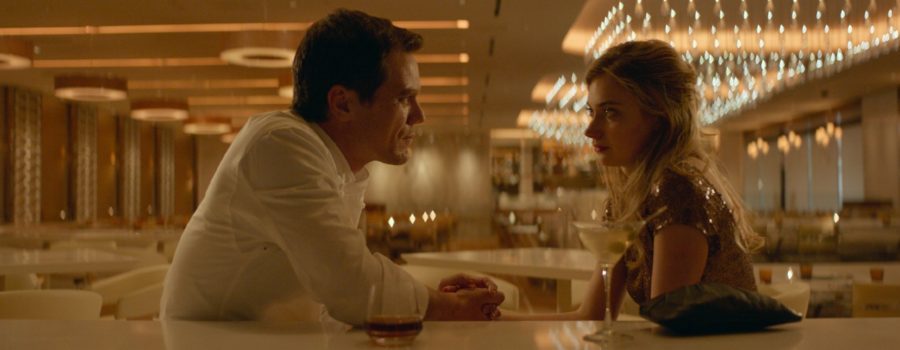 Michael Shannon is one of the best actors working today. He is not somebody that chooses his roles recklessly just to earn a paycheck. He is a thespian devoted to his craft. At first glance, one might think “Frank & Lola” is somewhat of a peculiar choice for Shannon, especially since he is putting his trust in first time writer and director Matthew Ross (different than actor/filmmaker Matt Ross who wrote and directed “Captain Fantastic“). However, after viewing Ross’ script, one can understand why Shannon chose this role; although tonally uneven and, at times, lazy, the script equips his character with a strong vehicle that allows him to flex his dramatic chops significantly. Ross’ film provides a multifaceted, complex look at the inveterate root of sexual desires, flawed masculinity, jealousy and love.
Michael Shannon is one of the best actors working today. He is not somebody that chooses his roles recklessly just to earn a paycheck. He is a thespian devoted to his craft. At first glance, one might think “Frank & Lola” is somewhat of a peculiar choice for Shannon, especially since he is putting his trust in first time writer and director Matthew Ross (different than actor/filmmaker Matt Ross who wrote and directed “Captain Fantastic“). However, after viewing Ross’ script, one can understand why Shannon chose this role; although tonally uneven and, at times, lazy, the script equips his character with a strong vehicle that allows him to flex his dramatic chops significantly. Ross’ film provides a multifaceted, complex look at the inveterate root of sexual desires, flawed masculinity, jealousy and love.
Shannon plays titular character A: Frank. Frank is a Las Vegas chef who starts a steamy romance with titular character B: The mysterious but alluring Lola (played by the tragically underutilized Imogen Poots). Minutes into the movie, the viewer finds out that Lola has a fetish with being held down forcibly during sex. Shannon goes along with her desires, albeit uncomfortably.
He soon realizes Lola is not quite who she says she is. She cheats on Frank, citing the fact that she was raped by her mother’s old French ex-boyfriend for her reason to act out sexually. This causes Frank to go into an obsessive inner battle among conflicting emotions of jealousy, anger, hatred and love. He becomes paranoid that Lola might sleep with her new boss, Keith (Justin Long), and fixated on her rapist, who he’s now tracked down in her phone book as Alan (Michael Nyqvist). Matthew Ross stretches the realism of this story considerably by using tired plot points. In this day and age, it is rare that a person under the age of 30 would still have a hardback handwritten contact book in the age of iPhones. It is too convenient of a pivotal plot point to include, and is admittedly a bit lazy and unrealistic, particularly from a Millennial’s perspective, as Lola falls into this generation
Shannon displays inner conflict (watch “Take Shelter”) better than any actor in the film industry today. His character in “Frank & Lola” exhibits such an unsettling calmness on the exterior, but subtle facial twitches, grimaces, body language and grunts collectively convey to the viewer how severely these mixed emotions are affecting his mental wellbeing. There are considerably long scenes of closeups of Shannon, in which he is trying to find out how to deal with his emotions, and when he looks at a given focal point with his characteristically piercing gaze and haunting eyes, it’s enough to raise the hairs on the back of anyone’s neck.
Keith, in an effort to earn Frank’s trust, uses his connections to get him an interview for a famous French chef (again, another very convenient plot point to move along the story). So, naturally, when Frank gets to France, after his interview, he pays Alan a visit, and, after confronting Alan about the rape, Alan shows a video of Lola and an unknown girl seemingly, willingly performing sexual acts on him. After this, he takes Frank, who, at this point, the viewer has to assume is on some sort of existential journey to understand both his mind better and that of Alan and Lola’s, to the same club where they picked up the anonymous other girl in the videotape. He takes a rich woman home with another woman and does the exact same things he saw in the video, as if he had a desire to know what it was like, at the same time despising it. He wanted to “corrupt” himself. He wanted to get even with Lola.
The audience eventually learns that Lola suffered from Stockholm Syndrome, a psychology term wherein the victim develops feelings of affection toward their captor. She then tells Frank that the man she cheated on him with was Alan, and that Alan played him by making his wife, who was the aforementioned rich woman, seduce him to distract him from his jealous rage. After they breakup, Frank is not finished with Alan; he refuses to accept Alan’s actions and his subsequent refusal to accept the consequences.
After going back to France to visit his new boss, he gains leverage on Alan by learning that his wife doesn’t know Alan continues to sleep with Lola. He learns that Alan is on another business trip, and assumes that he is back in Las Vegas with Lola. This is another illogical jump to move the plot along for Ross. After creepily standing out front of Lola’s apartment complex, he finally see’s Alan pull up in a chauffeured card. Alan gets out to greet Lola with flowers, but she stops him at the door. This is the moment where Frank finally trusts Lola, realizing they are equally flawed after no doubt having a “what am I doing right now?” moment. His last charade is to send a letter as Lola to Alan’s hotel room, asking to meet “her” at his restaurant. When Alan shows up and realizes he has been set up, a fight breaks out, which Frank wins, and Alan takes off back to France with his ego in his hands.
To spare viewers the climax, this review will not reveal the ending, but it is the best part of the film, sizably so. It is an emotionally resonant final conversation between Frank and Lola after all of the whirlwind of events that took place over the course of the 88-minute film. It is the calmest part of the movie. It is a conversation with little dialogue, characterized by Shannon and Poots’ inherent, respective abilities to convey so much emotion using only their faces as tools to communicate. It is one of the film’s saving graces
With a strong cast and assured direction to overcome an uneven screenplay, “Frank & Lola” proves to be a considerably watchable sexual thriller. It is essentially the grown-up, realistic version of “Fifty Shades of Grey.” It is everything “Fifty Shades” is not, and that is a wonderful thing. Unabashedly sexual movies intrinsically walk a fine line of acceptability due to society’s historical tendency to suppress sexual desire and any expression thereof. Ross wobbles a bit on that line, but never falters. The subject matter that this film covers is not easy to confront and convey, nor is it always easy for the viewer to digest, but ultimately it is a (as aforementioned), rewarding experience. At the age of 40, Ross has plenty of time to evolve as a filmmaker and storyteller and work out some of his kinks, pun intended.
“Frank & Lola” was distributed by Universal Pictures. It debuted at Sundance 2016, and was released into theaters on Dec. 9, 2016.
GRADE: (★★½)








Leave a Reply
Your email is safe with us.